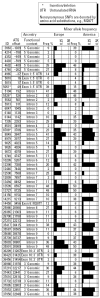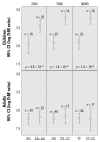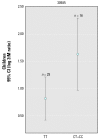Developmentally restricted genetic determinants of human arsenic metabolism: association between urinary methylated arsenic and CYT19 polymorphisms in children
- PMID: 15929903
- PMCID: PMC1257606
- DOI: 10.1289/ehp.7780
Developmentally restricted genetic determinants of human arsenic metabolism: association between urinary methylated arsenic and CYT19 polymorphisms in children
Abstract
We report the results of a screen for genetic association with urinary arsenic metabolite levels in three arsenic metabolism candidate genes, PNP, GSTO, and CYT19, in 135 arsenic-exposed subjects from the Yaqui Valley in Sonora, Mexico, who were exposed to drinking water concentrations ranging from 5.5 to 43.3 ppb. We chose 23 polymorphic sites to test in the arsenic-exposed population. Initial phenotypes evaluated included the ratio of urinary inorganic arsenic(III) to inorganic arsenic(V) and the ratio of urinary dimethylarsenic(V) to monomethylarsenic(V) (D:M). In the initial association screening, three polymorphic sites in the CYT19 gene were significantly associated with D:M ratios in the total population. Subsequent analysis of this association revealed that the association signal for the entire population was actually caused by an extremely strong association in only the children (7-11 years of age) between CYT19 genotype and D:M levels. With children removed from the analysis, no significant genetic association was observed in adults (18-79 years). The existence of a strong, developmentally regulated genetic association between CYT19 and arsenic metabolism carries import for both arsenic pharmacogenetics and arsenic toxicology, as well as for public health and governmental regulatory officials.
Figures



Similar articles
-
Association between polymorphisms in arsenic metabolism genes and urinary arsenic methylation profiles in girls and boys chronically exposed to arsenic.Environ Mol Mutagen. 2016 Aug;57(7):516-25. doi: 10.1002/em.22026. Epub 2016 Jun 21. Environ Mol Mutagen. 2016. PMID: 27327299 Free PMC article.
-
AS3MT, GSTO, and PNP polymorphisms: impact on arsenic methylation and implications for disease susceptibility.Environ Res. 2014 Jul;132:156-67. doi: 10.1016/j.envres.2014.03.012. Epub 2014 May 8. Environ Res. 2014. PMID: 24792412 Review.
-
Arsenic drinking water exposure and urinary excretion among adults in the Yaqui Valley, Sonora, Mexico.Environ Res. 2004 Oct;96(2):119-26. doi: 10.1016/j.envres.2003.08.010. Environ Res. 2004. PMID: 15325872
-
Genetic polymorphisms in glutathione S-transferase (GST) superfamily and arsenic metabolism in residents of the Red River Delta, Vietnam.Toxicol Appl Pharmacol. 2010 Feb 1;242(3):352-62. doi: 10.1016/j.taap.2009.11.007. Epub 2009 Nov 13. Toxicol Appl Pharmacol. 2010. PMID: 19914269
-
Arsenic methylation, urinary arsenic metabolites and human diseases: current perspective.J Environ Sci Health C Environ Carcinog Ecotoxicol Rev. 2007 Jan-Mar;25(1):1-22. doi: 10.1080/10590500701201695. J Environ Sci Health C Environ Carcinog Ecotoxicol Rev. 2007. PMID: 17365340 Review.
Cited by
-
Arsenic: Various species with different effects on cytochrome P450 regulation in humans.EXCLI J. 2021 Jul 12;20:1184-1242. doi: 10.17179/excli2021-3890. eCollection 2021. EXCLI J. 2021. PMID: 34512225 Free PMC article. Review.
-
AS3MT Gene Variant Shows Association with Skin Lesions in an Arsenic Exposed Population of India.Biol Trace Elem Res. 2025 Sep;203(9):4516-4528. doi: 10.1007/s12011-025-04515-2. Epub 2025 Jan 20. Biol Trace Elem Res. 2025. PMID: 39828879
-
Biologically based modeling of multimedia, multipathway, multiroute population exposures to arsenic.J Expo Sci Environ Epidemiol. 2008 Sep;18(5):462-76. doi: 10.1038/sj.jes.7500637. Epub 2007 Dec 12. J Expo Sci Environ Epidemiol. 2008. PMID: 18073786 Free PMC article.
-
Association between polymorphisms in arsenic metabolism genes and urinary arsenic methylation profiles in girls and boys chronically exposed to arsenic.Environ Mol Mutagen. 2016 Aug;57(7):516-25. doi: 10.1002/em.22026. Epub 2016 Jun 21. Environ Mol Mutagen. 2016. PMID: 27327299 Free PMC article.
-
The broad scope of health effects from chronic arsenic exposure: update on a worldwide public health problem.Environ Health Perspect. 2013 Mar;121(3):295-302. doi: 10.1289/ehp.1205875. Epub 2013 Jan 3. Environ Health Perspect. 2013. PMID: 23458756 Free PMC article.
References
-
- Calleja EM, Warrell RP., Jr Differentiating agents in pediatric malignancies: all-transretinoic acid and arsenic in acute promyelocytic leukemia. Curr Oncol Rep. 2000;2(6):519–523. - PubMed
-
- Chowdhury UK, Rahman MM, Sengupta MK, Lodh D, Chanda CR, Roy S, et al. Pattern of excretion of arsenic compounds [arsenite, arsenate, MMA(V), DMA(V)] in urine of children compared to adults from an arsenic exposed area in Bangladesh. J Environ Sci Health A Tox Hazard Subst Environ Eng. 2003;38(1):87–113. - PubMed
-
- Devlin B, Risch N. A comparison of linkage disequilibrium measures for fine-scale mapping. Genomics. 1995;29(2):311–322. - PubMed
Publication types
MeSH terms
Substances
Associated data
- Actions
- Actions
- Actions
Grants and funding
LinkOut - more resources
Full Text Sources
Medical
Molecular Biology Databases
Research Materials
Miscellaneous

